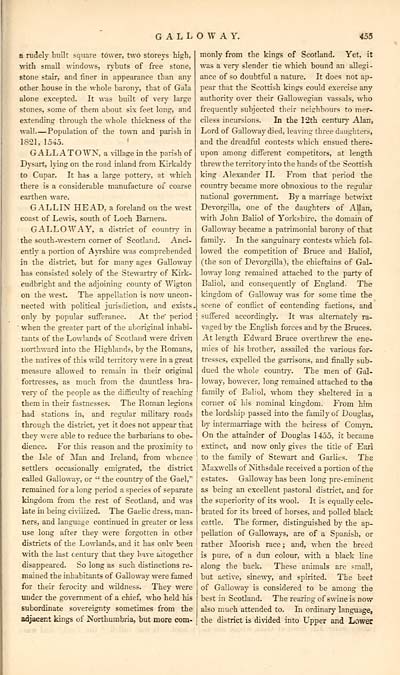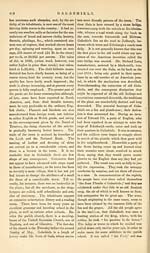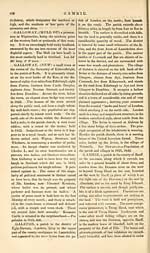Gazetteer of Scotland > Volume 1
(489) Page 455
Download files
Complete book:
Individual page:
Thumbnail gallery: Grid view | List view

GALLOWAY.
455
a rudely built square tower, two storeys high,
with small windows, rybuts of free stone,
stone stair, and finer in appearance than any
other house in the whole barony, that of Gala
alone excepted. It was built of very large
stones, some of them about six feet long, and
extending through the whole thickness of the
walJ Population of the town and parish in
1821, 1545.
GALLATOWN, a village in the parish of
Dysart, lying on the road inland from Kirkaldy
to Cupar. It has a large pottery, at which
there is a considerable manufacture of coarse
earthen ware.
GALLIN HEAD, a foreland on the west
coast of Lewis, south of Loch Barnera.
GALLOWAY, a district of country in
the south-western corner of Scotland. Anci-
ently a portion of Ayrshire was comprehended
in the district, but for many ages Galloway
has consisted solely of the Stewartry of Kirk-
cudbright and the adjoining count} - of Wigton
on the west. The appellation is now uncon-
nected with political jurisdiction, and exists
only by popular sufferance. At the' period
" when the greater part of the aboriginal inhabi-
tants of the Lowlands of Scotland were driven
northward into the Highlands, by the Romans,
the natives of this wild territory were in a great
measure allowed to remain in tbeir original
fortresses, as much from the dauntless bra-
very of the people as the difficulty of reaching
them in their fastnesses. The Roman legions
had stations in, and regular military roads
through the district, yet it does not appear that
they were able to reduce the barbarians to obe-
dience. For this reason and the proximity to
the Isle of Han and Ireland, from whence
settlers occasionally emigrated, the district
called Galloway, or '•' the country of the Gael,"
remained for a long period a species of separate
kingdom from the rest of Scotland, and was
late in being civilized. The Gaelic dress, man-
ners, and language continued in greater or less
use long after they were forgotten in other
districts of the Lowlands, and it has onlv been
with the last century that they have altogether
disappeared. So long as such distinctions re-
mained the inhabitants of Galloway were famed
for their ferocity 7 and wildness. They were
under the government of a chief, who held his
subordinate sovereignty sometimes from the
adjacent kings of Northumbria, but more com-
monly from the kings of Scotland. Yet, it
was a very slender tie which bound an allegi-
ance of so doubtful a nature. It does not ap-
pear that the Scottish kings could exercise any
authority over their Gallowegian vassals, who
frequently subjected their neighbours to mer-
ciless incursions. In the 12th century Alan,
Lord of Galloway died, leaving three daughters,
and the dreadful contests which ensued there-
upon among different competitors, at length
threw the territory into the hands of the Scottish
king Alexander II. From that period the
country became more obnoxious to the regular
national government. By a marriage betwixt
Devorgilla, one of the daughters of Allan,
with John Baiiol of Yorkshire, the domain of
Galloway became a patrimonial barony of that
family. In the sanguinary contests which fol-
lowed the competition of Bruce and Baiiol,
(the son of Devorgilla), the chieftains of Gal-
loway long remained attached to the party of
Baiiol, and consequently of England. The
kingdom of Galloway was for some time the
scene of conflict of contending factions, and
suffered accordingly. It was alternately ra-
vaged by the English forces and by the Braces.
At length Edward Bruce overthrew the ene-
mies of his brother, assailed the various for-
tresses, expelled the garrisons, and finally sub-
dued the whole country. The men of Gal-
loway, however, long remained attached to the
family of Baiiol, whom they sheltered in a
comer of his nominal kingdom. From him
the lordship passed into the family of Douglas,
by intermarriage with the heiress of Comyn.
On the attainder of Douglas 1 455, it became
extinct, and now only gives the title of Earl
to the family of Stewart and Garbles. The
Maxwells of Nithsdale received a portion of the
estates. Galloway has been long pre-eminent
as being an excellent pastoral district, and for
the superiority of its wool. It is equally cele-
brated for its breed of horses, and polled black
cattle. The former, distinguished by the ap-
pellation of Galloways, are of a Spanish, or
rather Moorish race; and, when the breed
is pure, of a dun colour, with a black line
along the back. These animals are small,
but active, sinewy, and spirited. The beet
of Galloway is considered to be among the
best in Scotland. The rearing of swine is now
also much attended to. In ordinary language,
the district is divided into Upper and Lower
455
a rudely built square tower, two storeys high,
with small windows, rybuts of free stone,
stone stair, and finer in appearance than any
other house in the whole barony, that of Gala
alone excepted. It was built of very large
stones, some of them about six feet long, and
extending through the whole thickness of the
walJ Population of the town and parish in
1821, 1545.
GALLATOWN, a village in the parish of
Dysart, lying on the road inland from Kirkaldy
to Cupar. It has a large pottery, at which
there is a considerable manufacture of coarse
earthen ware.
GALLIN HEAD, a foreland on the west
coast of Lewis, south of Loch Barnera.
GALLOWAY, a district of country in
the south-western corner of Scotland. Anci-
ently a portion of Ayrshire was comprehended
in the district, but for many ages Galloway
has consisted solely of the Stewartry of Kirk-
cudbright and the adjoining count} - of Wigton
on the west. The appellation is now uncon-
nected with political jurisdiction, and exists
only by popular sufferance. At the' period
" when the greater part of the aboriginal inhabi-
tants of the Lowlands of Scotland were driven
northward into the Highlands, by the Romans,
the natives of this wild territory were in a great
measure allowed to remain in tbeir original
fortresses, as much from the dauntless bra-
very of the people as the difficulty of reaching
them in their fastnesses. The Roman legions
had stations in, and regular military roads
through the district, yet it does not appear that
they were able to reduce the barbarians to obe-
dience. For this reason and the proximity to
the Isle of Han and Ireland, from whence
settlers occasionally emigrated, the district
called Galloway, or '•' the country of the Gael,"
remained for a long period a species of separate
kingdom from the rest of Scotland, and was
late in being civilized. The Gaelic dress, man-
ners, and language continued in greater or less
use long after they were forgotten in other
districts of the Lowlands, and it has onlv been
with the last century that they have altogether
disappeared. So long as such distinctions re-
mained the inhabitants of Galloway were famed
for their ferocity 7 and wildness. They were
under the government of a chief, who held his
subordinate sovereignty sometimes from the
adjacent kings of Northumbria, but more com-
monly from the kings of Scotland. Yet, it
was a very slender tie which bound an allegi-
ance of so doubtful a nature. It does not ap-
pear that the Scottish kings could exercise any
authority over their Gallowegian vassals, who
frequently subjected their neighbours to mer-
ciless incursions. In the 12th century Alan,
Lord of Galloway died, leaving three daughters,
and the dreadful contests which ensued there-
upon among different competitors, at length
threw the territory into the hands of the Scottish
king Alexander II. From that period the
country became more obnoxious to the regular
national government. By a marriage betwixt
Devorgilla, one of the daughters of Allan,
with John Baiiol of Yorkshire, the domain of
Galloway became a patrimonial barony of that
family. In the sanguinary contests which fol-
lowed the competition of Bruce and Baiiol,
(the son of Devorgilla), the chieftains of Gal-
loway long remained attached to the party of
Baiiol, and consequently of England. The
kingdom of Galloway was for some time the
scene of conflict of contending factions, and
suffered accordingly. It was alternately ra-
vaged by the English forces and by the Braces.
At length Edward Bruce overthrew the ene-
mies of his brother, assailed the various for-
tresses, expelled the garrisons, and finally sub-
dued the whole country. The men of Gal-
loway, however, long remained attached to the
family of Baiiol, whom they sheltered in a
comer of his nominal kingdom. From him
the lordship passed into the family of Douglas,
by intermarriage with the heiress of Comyn.
On the attainder of Douglas 1 455, it became
extinct, and now only gives the title of Earl
to the family of Stewart and Garbles. The
Maxwells of Nithsdale received a portion of the
estates. Galloway has been long pre-eminent
as being an excellent pastoral district, and for
the superiority of its wool. It is equally cele-
brated for its breed of horses, and polled black
cattle. The former, distinguished by the ap-
pellation of Galloways, are of a Spanish, or
rather Moorish race; and, when the breed
is pure, of a dun colour, with a black line
along the back. These animals are small,
but active, sinewy, and spirited. The beet
of Galloway is considered to be among the
best in Scotland. The rearing of swine is now
also much attended to. In ordinary language,
the district is divided into Upper and Lower
Set display mode to: Large image | Transcription
Images and transcriptions on this page, including medium image downloads, may be used under the Creative Commons Attribution 4.0 International Licence unless otherwise stated. ![]()
| Gazetteers of Scotland, 1803-1901 > Gazetteer of Scotland > Volume 1 > (489) Page 455 |
|---|
| Permanent URL | https://digital.nls.uk/97430230 |
|---|
| Description | Volume I: Abbey to Glenartney. |
|---|---|
| Attribution and copyright: |
|
| Description | By Robert Chambers and William Chambers. Glasgow: Blackie & Son, 1838. 2 volumes. |
|---|---|
| Shelfmark | NF.1461.g.7 |
| Additional NLS resources: | |

